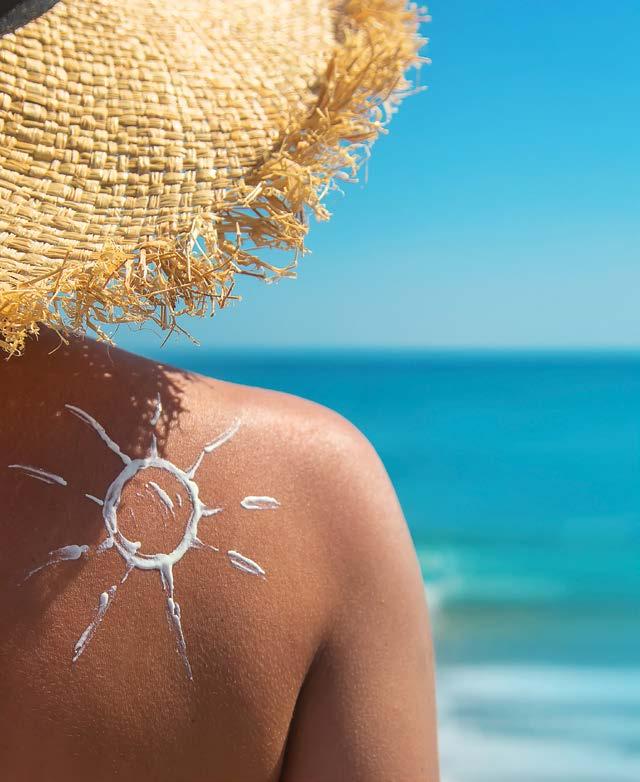
5 minute read
Reef-safe sunscreen: protecting your skin and the oceans
Did you know that just because a sunscreen label says “reef safe”, there’s a very good chance that it actually is not?
Here in Antigua & Barbuda, we are fortunate to be surrounded by beautiful coral reefs that provide shelter and food for many marine species, offer protection during storms and support our local economy. However, these beautiful underwater ecosystems are facing grave threats, including climate change, pollution, and, increasingly, the toxic chemicals found in everyday products like sunscreen.
In recent years, the term ‘reef-safe’ sunscreen has gained popularity, with many beachgoers reaching for those labelled as safe for coral reefs. But what does “reef-safe” really mean? And why should you choose a sunscreen with non-nano zinc oxide as its only active ingredient?
THE TOXIC EFFECTS OF CONVENTIONAL SUNSCREENS ON CORALS
Sunscreen is a crucial part of sun protection, especially in tropical and coastal regions. But what many don’t realise is that most conventional formulas come with a hidden cost, harming marine life, particularly corals. Oxybenzone and octinoxate, two common chemical sunscreen ingredients, have been shown to cause coral bleaching and damage to the coral DNA, leading to the death of coral colonies. These toxic ingredients also disrupt the development of marine organisms and contribute to the accumulation of harmful substances in the food chain. Corals are extremely sensitive to changes in their environment. Just a tiny amount of toxic sunscreen can cause coral to expel the algae that live symbiotically within their tissues, a process known as coral bleaching. Without these algae, the coral loses its vibrant colour and slowly dies, potentially causing the collapse of the entire reef ecosystem.
JUST BECAUSE IT SAYS “REEF-SAFE” DOESN’T MEAN IT IS
Unfortunately, not all sunscreens labelled “reef-safe” are truly safe for the marine environment. Surprisingly, the term is not regulated, meaning companies can use the label without meeting any specific standards. Some sunscreens marketed as ‘reef-safe’ still contain harmful chemicals determined to be toxic to corals and other marine life. To make an informed choice, it’s essential to read the ingredient list carefully and look for a sunscreen that uses only non-nano zinc oxide, a recognised safe alternative for both human and marine life.
Corals are extremely sensitive to changes in their environment. Just a tiny amount of toxic sunscreen can cause coral to expel the algae that live symbiotically within their tissues, a process known as coral bleaching.
Beyond the ingredients, it’s essential also to consider other factors, such as the packaging of the sunscreen. Many come in plastic containers, contributing to the growing problem of ocean plastic pollution and microplastic in the sunscreen. Opting for products with sustainable, recyclable, or biodegradable packaging can further reduce the negative impact. Wearing sun-protective clothing or avoiding the sun altogether in the middle of the day are other options.
THE ROLE OF NON-NANO ZINC OXIDE IN REEF-SAFE SUNSCREENS
To avoid contributing to the degradation of coral reefs and marine life, it’s essential to choose a sunscreen with ingredients that are safe for both you and the aquatic environment. Zinc oxide, a mineral-based ingredient used for centuries for its sun-blocking properties, is a much safer option. Unlike chemical sunscreens, which absorb UV rays and convert them into heat, zinc oxide works as a physical blocker, sitting on the surface of the skin and reflecting harmful UV rays. This provides broad-spectrum protection from both UVA and UVB rays without causing harm to marine ecosystems.
But why is non-nano zinc oxide specifically so important? The term ‘nano’ refers to the size of the particles in a sunscreen. Nano-sized particles are small enough to penetrate the skin and enter the bloodstream, raising concerns about their long-term health effects. In contrast, non-nano zinc oxide particles are larger and remain on the skin’s surface, offering both effective sun protection and a reduced risk of absorption into the body. This makes non-nano zinc oxide a safer choice for human health and the environment alike.
PROTECTING ANTIGUA & BARBUDA'S CORAL REEFS
Antigua & Barbuda has three coral restoration programmes helping corals survive environmental challenges. Eliminating sunscreen pollution is one factor that is within our control. In keeping with efforts to protect the country’s marine environment, Minister of Tourism Max Fernandez recently announced that Antigua & Barbuda will soon be joining the increasing number of countries banning the toxic chemicals commonly found in these products. In support of this effort, there is currently an island-wide community education campaign, which is educating both residents and visitors on the detrimental effects of these chemicals. An updated list of where you can purchase reef-safe sunscreens can be found on posters around the island. Choosing the right sunscreen is more than just about protecting your skin; it’s about preserving the delicate balance of our oceans and the life within them. By opting for reef-safe sunscreens that use only non-nano zinc oxide, you’re not only safeguarding your skin from harmful UV rays but also ensuring that you’re not contributing to the destruction of our precious coral reefs and marine habitat. The next time you reach for sunscreen, remember that your choices matter- for both your health and the health of our marine ecosystem.
Article written by Julie Harvey Esty, founding director of ABOT. For more information, please contact Antigua & Barbuda Ocean Trust (ABOT) at www.abocean.org










